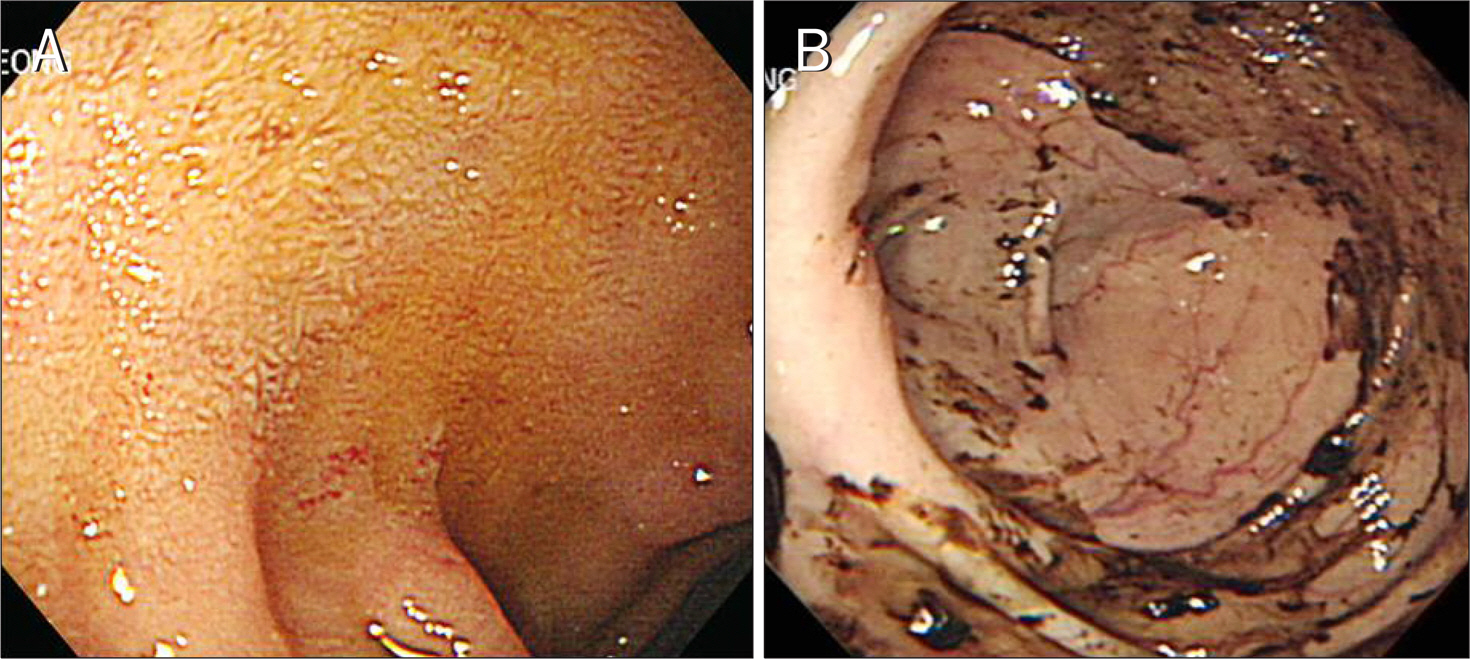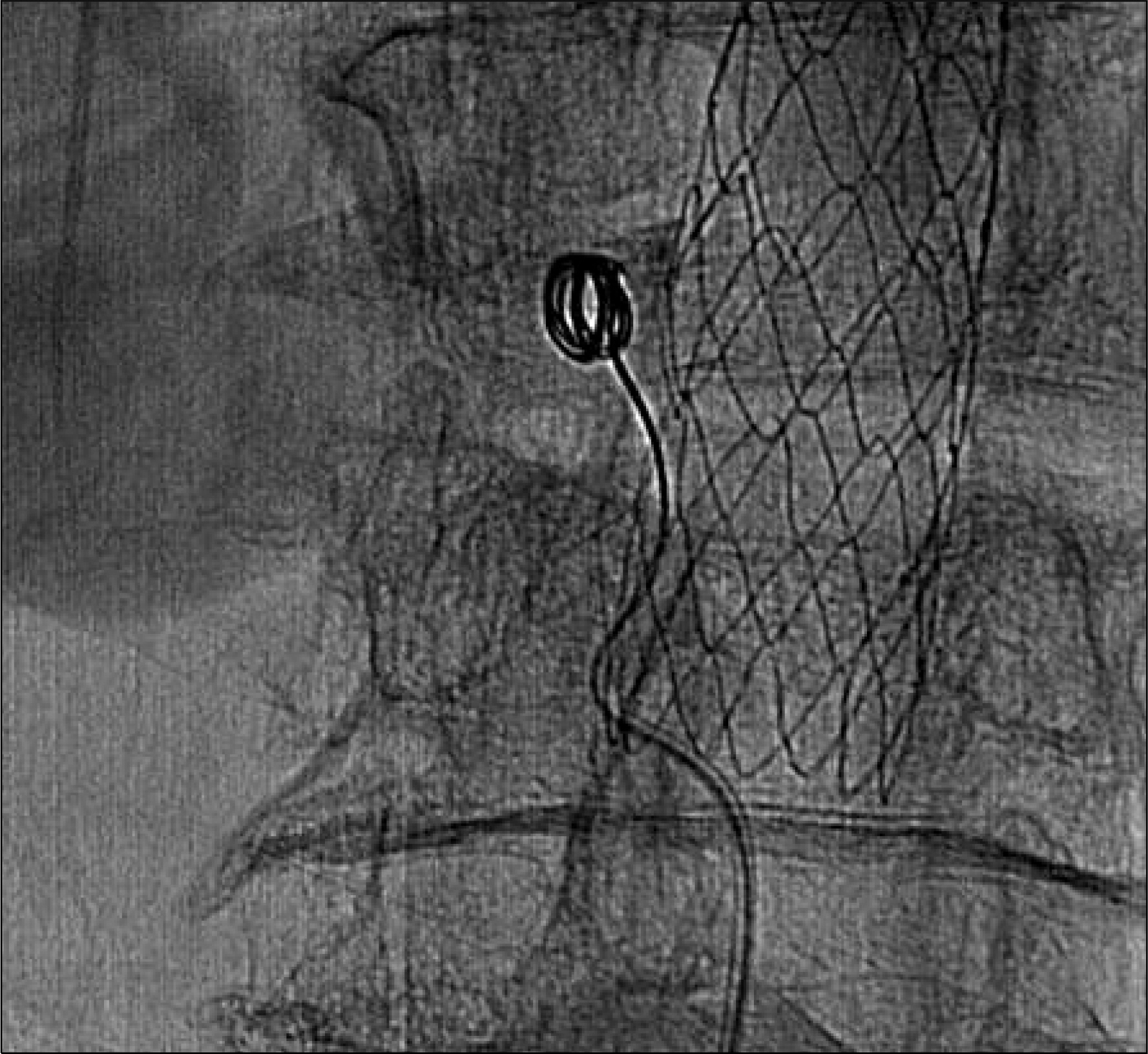Korean J Gastroenterol.
2013 Apr;61(4):230-233. 10.4166/kjg.2013.61.4.230.
A Case of Angiographic Embolization of Aortoenteric Fistula Caused by Endovascular Stent Grafting for an Abdominal Aortic Aneurysm
- Affiliations
-
- 1Department of Internal Medicine, Chungnam National University School of Medicine, Daejeon, Korea. mhs1357@hanmail.net
- KMID: 1775764
- DOI: http://doi.org/10.4166/kjg.2013.61.4.230
Abstract
- Aortoenteric fistula (AEF) developed after treatment for an abdominal aortic aneurysm (AAA) is a rare but usually fatal complication. We report a rare case of AEF bleeding after endovascular stent grafting for AAA which was managed angiographically. An 81-year-old man presented with hematochezia and acute abdominal pain for 1 day ago. Four years ago, an aortic stent was implanted in the infrarenal aorta for AAA. Endoscopies were performed to evaluate the hematochezia. Evidence of gastrointestinal bleeding was observed, but a clear bleeding point was not detected on upper endoscopy and colonoscopy. Contrast-enhanced computed tomography performed subsequently showed that the bleeding point was located in the fourth portion of the duodenum as an AEF caused by an inflammatory process in the stent-graft. Intra-arterial angiography showed a massive contrast leakage into the bowel via a small fistula from around the aortic stent graft site. Embolization was successfully performed by injecting a mixture of glue and lipiodol into the AEF tract. The patient was discharged with no evidence of gastrointestinal bleeding after the embolization.
MeSH Terms
Figure
Reference
-
References
1. Flye MW, Thompson WM. Aortic graft-enteric and para-prosthetic-enteric fistulas. Am J Surg. 1983; 146:183–187.
Article2. Voorhoeve R, Moll FL, de Letter JA, Bast TJ, Wester JP, Slee PH. Primary aortoenteric fistula: report of eight new cases and review of the literature. Ann Vasc Surg. 1996; 10:40–48.
Article3. Reynolds JV, Galloway JM. Primary aortoduodenal fistula: a case report and review of the literature. Ir J Med Sci. 1991; 160:381–384.
Article4. Brock RC. Aortic homografting; a report of six successful cases. Guys Hosp Rep. 1953; 102:204–228.5. Birch L, Cardwell ES, Claytor H, Zimmerman SL. Suture-line rupture of a nylon aortic bifurcation graft into the small bowel. AMA Arch Surg. 1956; 73:947–950.6. Yu SB, Park SC, Moon IS, Koh YB. Primary aortoduodenal fistula in salmonella mycotic aortic aneurysm: a case report. J Korean Soc Vasc Surg. 2003; 19:79–82.7. Kalman DR, Barnard GF, Massimi GJ, Swanson RS. Primary aortoduodenal fistula after radiotherapy. Am J Gastroenterol. 1995; 90:1148–1150.8. Broadbent NR, Taylor DE. Gallstone erosion of the aorta. Aust N Z J Surg. 1975; 45:207–208.
Article9. Saers SJ, Scheltinga MR. Primary aortoenteric fistula. Br J Surg. 2005; 92:143–152.
Article10. Berry SM, Fischer JE. Classification and pathophysiology of enterocutaneous fistulas. Surg Clin North Am. 1996; 76:1009–1018.
Article11. Sweeney MS, Gadacz TR. Primary aortoduodenal fistula: manifestation, diagnosis, and treatment. Surgery. 1984; 96:492–497.12. Elliott JP Jr, Smith RF, Szilagyi DE. Proceedings: Aortoenteric and paraprosthetic-enteric fistulas. Problems of diagnosis and management. Arch Surg. 1974; 108:479–490.13. Korkut AK, Arpinar E, Yasar T, Guney D. Primary aortoduodenal fistula complicated by abdominal aortic aneurysm. J Cardiovasc Surg (Torino). 2000; 41:113–115.14. Mylona S, Ntai S, Pomoni M, Kokkinaki A, Lepida N, Thanos L. Aortoenteric fistula: CT findings. Abdom Imaging. 2007; 32:393–397.
Article15. Brand EJ, Sivak MV Jr, Sullivan BH Jr. Aortoduodenal fistula: endoscopic diagnosis. Dig Dis Sci. 1979; 24:940–944.16. Kim JY, Kim YW, Kim CJ, Lim HI, Kim DI, Huh S. Successful surgical treatment of aortoenteric fisula. J Korean Med Sci. 2007; 22:846–850.17. Loftus IM, Thompson MM, Fishwick G, et al. Technique for rapid control of bleeding from an aortoenteric fistula. Br J Surg. 1997; 84:1114.
Article18. Karkos CD, Bruce IA, Lambert ME. Use of the intra-aortic balloon pump to arrest gastrointestinal bleeding. Ann Emerg Med. 2001; 38:328–331.19. Finch L, Heathcock RB, Quigley T, et al. Emergent treatment of a primary aortoenteric fistula with N-butyl 2-cyanoacrylate and endovascular stent. J Vasc Interv Radiol. 2002; 13:841–843.
Article20. Cekirge S, Oguzkurt L, Saatci I, et al. Embolization of a high-out-put post-nephrectomy aortocaval fistula with Gianturco coils and cyanoacrylate. Cardiovasc Intervent Radiol. 1996; 19:56–58.
Article
- Full Text Links
- Actions
-
Cited
- CITED
-
- Close
- Share
- Similar articles
-
- Primary Aortoenteric Fistula of a Saccular Aneurysm: Case Study and Literature Review
- A case of aortoduodenal fistula and vertebral erosion caused by an abdominal aortic aneurysm
- Unusual Perigraft Abscess Formation Associated with Stent Graft Infection after Endovascular Aortic Repair of Abdominal Aortic Aneurysm: A Case Report
- Aorto-Uni-Iliac Stent Grafting and Femoro-Femoral Bypass in a Patient with a Failed and Catastrophic Endovascular Aortic Aneurysm Repair
- Stented Aortic Graft Insertion in an Infrarenal Abdominal Aortic Aneurysm as Performed by Cardiovascular Surgeons: Report of 3 cases






